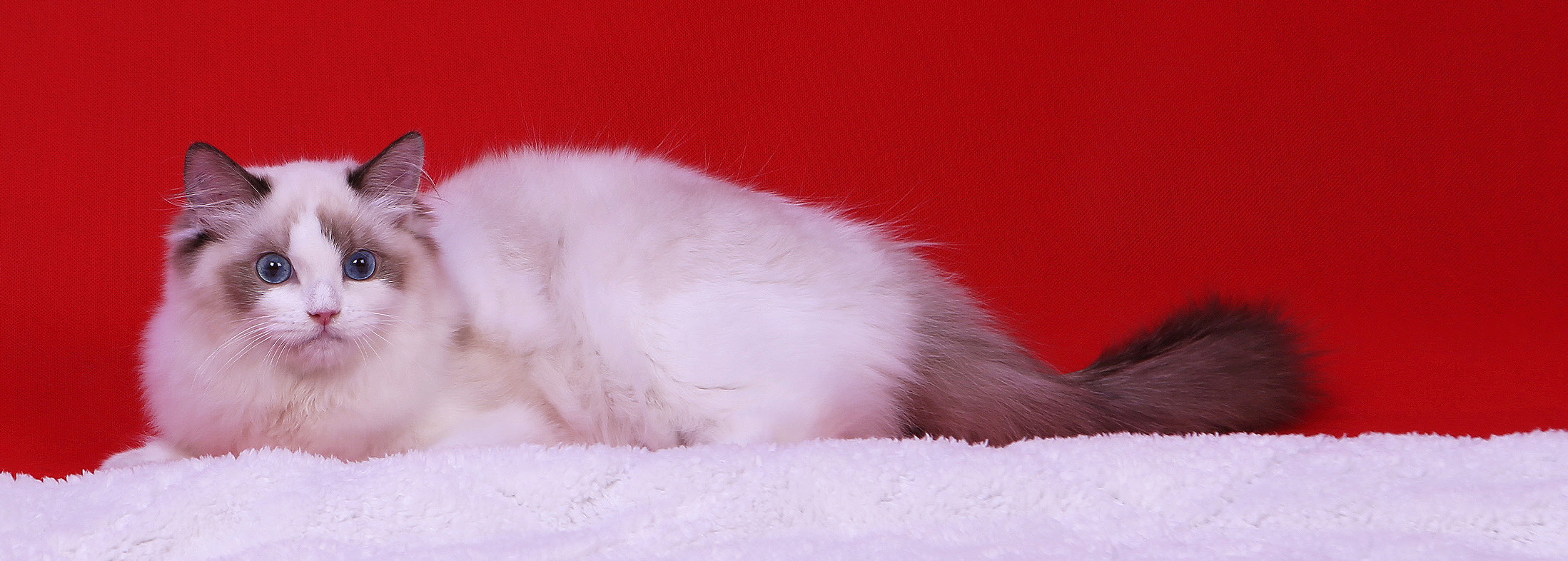Because the Ragdoll’s background is so controversial that it includes an allusion to aliens, you might think it difficult for cats of this breed to be well loved by many families worldwide—that is, until you meet one.
With a Ragdoll in your arms, you will find it hard to ignore its irresistible charm. Perhaps that’s why the Ragdoll’s reputation remains unscathed by its history.
Ragdolls are loving, gentle, and loyal, with a tendency to follow their humans around like canines do. No wonder they are known as the “puppies” of the feline world!

The Ragdoll has been a part of Filipino families for almost twenty years. “The breed is not new to the country and was brought in [around] the early 2000s,” says self-confessed Ragdoll enthusiast Manny Go, president of Agprodeq Solutions, Inc.
“About three years ago when I was looking for a companion [in a] home with limited space, I researched on what breed of cat to consider and was quickly drawn to the Ragdoll. I learned that very, very limited new stocks were brought in since then to reinvigorate the local lines. Being a true animal breeder by heart, I searched the world to bring in the very best lines possible from the most ethical of breeders who would be willing to share their most precious babies.”
Long hair, long memory
Aside from its semi-long hair, the Ragdoll’s rather long memory is also one of its defining traits, distinguishing it from other breeds with a similar coat, according to Go.
“[Ragdolls are] an extremely intelligent cat breed. They do remember the love and trauma [they experience with] their fur-parents and the environment they live in!”
Painful experiences aside, Ragdolls usually have a mild temperament. “They are generally very sociable. [They] truly seek the attention and [company] of their fur-parents and follow them around the house, which is why [they are often described as] ‘dog-like’.”
However, the “melting” rag-doll trait the breed is supposed to have is not always a given. “Their sweet temperament is not absolute [but] is deeply rooted in their breeding. Socialization and a proper family environment can bring out their natural character. They live well with children and other pets at home if properly introduced.”
Care tips for the newbie Ragdoll purrent
Ragdolls need a little TLC to keep them happy and healthy. Go shares these tips for loving Ragdoll parents.
- Keep their fur healthy. “Twice-a-week brushing should be optimal. The use of a rubber-tipped or round-bristled hairbrush is best. However, I brush my cats as often as possible, not only because it keeps them clean and their coats in [good] condition but [also] because they enjoy it a lot. Brushing has a calming effect on them and is a great reinforcing tool to establish the bond between fur-parent and kitten.”
- Keep them dirt-free. “Bathing at least once a month should keep the coat in [its] best condition.”
- Keep them cool. “Air conditioning, especially during the [hottest days] of summer, helps a lot in keeping their coats in optimal condition and in keeping them comfortable.”
- Keep them nourished with the best protein sources. “Being a large, semi-long-haired breed, the Ragdoll [needs] the best sources of digestible animal protein. Being the obligate carnivores that they are, they will have multiple life-threatening problems if they are fed [food with] extenders not suitable for felines. Ensure a balanced diet rich in amino acids, with optimal levels of minerals, taurine, and vitamins.”

- Keep them company. “As far as attention goes, they love being the center of it! This is a breed that seeks out human company, not displaying the typical aristocratic cat disposition. If you like a sweet, gentle, childlike cat, [the Ragdoll] is perfect for you!”
- Keep them indoors. “They have lost the ability to defend themselves. They can be harmed by other animals in the outdoors. They are also a very curious and trusting breed: Unsupervised access to the outdoors can bring trouble and they can be easily picked up by other people.”
- Keep them active. “Ragdolls are generally muscular. They can be quite active yet laidback as they mature. An optimal diet with daily playtime will keep them happy and in good physical condition throughout their lives.”
- Keep them free from disease. “Health is paramount. Make sure your breeder tests for all genetic feline diseases. The cattery [should also be] periodically tested for feline immunodeficiency virus (FIV) and feline leukemia virus (FELV). Establish a good relationship with your vet and bring your cats to the clinic for regular checkups.”
- Keep them, period! “Ragdolls are not commodities you can just buy and dispose of when no longer convenient. They love their humans and ask for lifelong commitment. Caging is [also] not an option!”

Looking for a Ragdoll?
Remember that each cat, Ragdoll or otherwise, is one of a kind. Accept and love the cats in your care for what they are, not for what you expect them to be. Provide the right environment and show them how to interact with other humans and animals at an early age so that they grow up to be the best version of themselves.
“While there are general descriptions for a Ragdoll, each cat is unique with distinct personalities. To me, they are the perpetual toddlers always wanting companionship and playtime. They can be truly stunning to the eye of a feline fancier – a complete package of a cat, as far as I am concerned,” says Go.
To discourage irresponsible breeding, Go advises cat parents-to-be to seek out only the most ethical of breeders. “Know your breed, your breeder, and your cat.”
This appeared in Animal Scene’s October 2016 issue.






